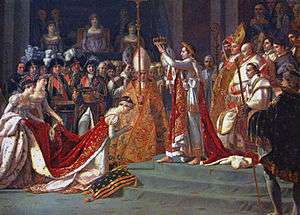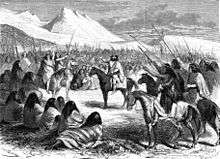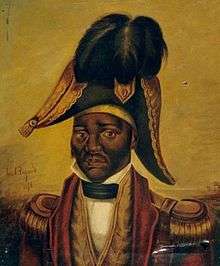Self-proclaimed monarchy
A self-proclaimed monarchy is established when a person claims a monarchy without any historical ties to a previous dynasty. The self-proclaimed monarch may be of an established state, such as Zog I of Albania, or of an unrecognised micronation, such as Leonard Casley of Hutt River, Western Australia.

Past self-proclaimed monarchies
Albania
In 1928, Ahmet Zogu, a president of Albania, proclaimed himself "King Zog I".[1] He ruled for 11 years in a constitutional monarchy that was overthrown in the Italian invasion of Albania.[2]
Andorra
In 1934, Boris Skossyreff declared himself "Boris I, King of Andorra”. After months in power, he was expelled when he declared war on Justí Guitart i Vilardebó, a Spanish co-prince of Andorra.[3]
Central African Republic
In 1976, a short-lived 'Imperial' monarchy, the "Central African Empire", was created when dictator Jean-Bédel Bokassa of the Central African Republic proclaimed himself "Emperor Bokassa I". In 1977, he held a lavish coronation ceremony.[4]
Chile

In 1860, a French adventurer, Orélie-Antoine de Tounens, proclaimed the "Kingdom of Araucanía" in Chile with the support of local Mapuche chiefs. He called himself "Orélie-Antoine I". In 1862, he was arrested and deported by the Chilean government.
China
In 1915, the president of China, Yuan Shikai, declared a restoration of the Chinese monarchy, with himself as emperor. The plan failed, and he was forced to step down.[5]
Congo
Within days of being independent from Belgium, the new Republic of the Congo found itself torn between competing political factions, as well as by foreign interference. As the situation deteriorated, Moise Tshombe declared the independence of Katanga Province as the State of Katanga on 11 July 1960. Albert Kalonji, claiming that the Baluba were being persecuted in the Congo and needed their own state in their traditional Kasai homeland, followed suit shortly afterwards and declared the autonomy of South Kasai on 8 August, with himself as head.[6] On 12 April 1961, Kalonji's father was granted the title Mulopwe (which roughly translates to "emperor" or "god-king"),[7] but he immediately "abdicated" in favor of his son.[6] On 16 July, but retained the title of Mulopwe and changed his name to Albert I Kalonji Ditunga.[8] The move was controversial with members of Kalonji's own party and cost him much support.
Shortly thereafter, as preparation for the invasion of Katanga, Congolese government troops invaded and occupied South Kasai, and Kalonji was arrested.[6] He escaped, but South Kasai ultimately returned to the Congo.[6]
France
In 1736, Theodor Stephan Freiherr von Neuhoff established himself as King of Corsica in an attempt to free the island of Corsica from Genoese rule.[9]
In 1804, French Consul Napoleon Bonaparte proclaimed himself "Emperor Napoleon I".[10] Although this imperial regime ended with his fall from power, Napoleon's nephew, Louis-Napoléon Bonaparte, was elected in 1848 as President of France. In 1852, he declared himself "Emperor Napoleon III"; he was deposed in 1870.[11]
Haiti

In 1804, in Haiti, the governor general, Jean-Jacques Dessalines, proclaimed himself "Emperor Jacques I". He ruled for two years.[12] In 1811, the president, Henry Christophe proclaimed himself "King Henri I" and ruled until 1820.[13] In 1849, the president, Faustin Soulouque, proclaimed himself "Emperor Faustin I" and ruled until 1859.[14]
Philippines
In 1823, in Manila, Philippines, a regimental captain, Andrés Novales, staged a mutiny and proclaimed himself "Emperor of the Philippines". After one day, Spanish troops from Pampanga and Intramuros removed him.[15]
Trinidad
In 1893, James Harden-Hickey, an admirer of Napoleon III, crowned himself "James I of the Principality of Trinidad".[16] For two years he tried but failed to assert his claim.
United States
In 1850, James J. Strang, who claimed to be Joseph Smith's successor as leader of the Latter Day Saint movement, proclaimed himself king of his followers on Beaver Island, Michigan. On 8 July 1850, he was crowned in an elaborate coronation ceremony. Strang evaded Federal government charges of treason and continued to rule until 1856, the year he was assassinated by two disgruntled "Strangites".[17]
In 1859, Joshua Abraham Norton declared himself "Norton I, Emperor of the United States"[18] and "Protector of Mexico" in 1863. His claim was acknowledged by the San Francisco Police.
Current self-proclaimed monarchies
Australia
In 1970, after a dispute over wheat production quotas, Leonard Casley proclaimed his wheat farm in Western Australia the "Principality of Hutt River", styling himself as "HRH Prince Leonard I of Hutt".[19] The Australian government does not recognize his claim of independence.[20]
Italy
The Principality of Seborga (italian: Principato di Seborga) is a micronation that claims a 14 square kilometres (5.4 sq mi) area located in the northwestern Italian Province of Imperia in Liguria, near the French border, and about 35 kilometres (22 mi) from Monaco.[21] The principality is in coexistence with, and claims the territory of, the town of Seborga. In the early 1960s, Giorgio Carbone, began promoting the idea that Seborga restore its historic independence as a principality.[22][23] By 1963 the people of Seborga were sufficiently convinced of these arguments to elect Carbone as their Head of State. He then assumed the style and title His Serene Highness Giorgio I, Prince of Seborga, which he held until his death in 2009. The Principality of Seborga is an elective monarchy and elections are held every seven years. The subsequent monarch was Prince Marcello Menegatto (Prince Marcello I) who ruled from 2010 to 2019. On 23 April 2017, Prince Marcello was re-elected and took office for another seven years,[24] but abdicated the throne in 2019.[25] Nina Menegatto was elected head of state as Princess Nina on 10 November 2019.[26]
United Kingdom
In 1967, Paddy Roy Bates, a former major in the British Army, took control of Roughs Tower, a Maunsell sea fort situated off the coast of Suffolk and declared it the "Principality of Sealand".[27] Upon his death in 2012, "Prince" Paddy Roy Bates was succeeded by his son, Michael.[28]
References
- Albania holds funeral for self-styled King Leka FOX News. Accessed 11 February 2013.
- Keegan J. and Churchill W. The Second World War Mariner Books, Boston 1986 p314 ISBN 0-395-41685-X.
- ""Spain week by week"". Bulletin of Spanish Studies. 11 (44): 209–216. 1934. doi:10.1080/14753825012331364384.
- Five most notorious African warlords US news.
- Kuo T'ing-i et al. Historical Annals of the ROC (1911–1949). Vol 1. p 207 - 241.
- The Imperial Collection: The Autonomous State of South Kasai
- "''Zaire: A Country Study'', "Establishment of a Personalistic Regime"". Lcweb2.loc.gov. Retrieved 2014-08-03.
- Ben Cahoon. "Provinces of Belgian Congo and Congo (Kinshasa)". Worldstatesmen.org. Retrieved 2014-08-03.
- Regarding personal names: Freiherr was a title before 1919, but now is regarded as part of the surname. It is translated as Baron. Before the August 1919 abolition of nobility as a legal class, titles preceded the full name when given (Graf Helmuth James von Moltke). Since 1919, these titles, along with any nobiliary prefix (von, zu, etc.), can be used, but are regarded as a dependent part of the surname, and thus come after any given names (Helmuth James Graf von Moltke). Titles and all dependent parts of surnames are ignored in alphabetical sorting. The feminine forms are Freifrau and Freiin.
- Porterfield, Todd Burke; Siegfried, Susan L. (2006). Staging empire: Napoleon, Ingres, and David. Penn State Press. p. 4. ISBN 978-0-271-02858-3. Retrieved 1 December 2011.
- Nohlen & Stöver, p683
- "Slave Revolt in St. Domingue".
- Cheesman, 2007.
- The impact of the Haitian Revolution in the Atlantic world. David Patrick Geggus (ed), p. 25. University of South Carolina Press, 2001. ISBN 1-57003-416-8, ISBN 978-1-57003-416-9.
- Joaquin, Nick (1990). Manila,My Manila. Vera-Reyes, Inc.
- "To Be Prince of Trinidad: He Is Baron Harden-Hickey," New York Tribune, Nov 5, 1893, p 1
- "History and Succession". Strangite.org. Retrieved on 2007-10-28. This compares to approximately 50,000 for Brigham Young at this same time. See "Church membership: 1830–2006," at .
- Smith, Fred (January 31, 2002). "Emperor Joshua Norton I of America". BBC. Retrieved April 15, 2007.
- "Secession Success". The Advertiser. 8 June 2008.
- "What is the Hutt River Province?". australia.gov.au. 1999-02-22. Retrieved 2014-04-30.
- "Self-Proclaimed Micronations", WorldStatesmen.org
- "Prince of Seborga fights on for 362 subjects", Italy Magazine, 15 June 2006
- http://m.huffpost.com/uk/entry/5760864
- Squires, Nick (18 March 2017). "Radio DJ from West Sussex vies to become next leader of tiny self-declared principality in Italy". The Telegraph. Archived from the original on 18 March 2017. Retrieved 20 March 2017.
- Letter of resignation on principatodiseborga.com
- Vogt, Andrea (10 November 2019). "'Her Tremendousness' elected leader of self-declared micro-nation on hilltop in Italy". The Daily Telegraph. Retrieved 11 November 2019.
- Strauss, Erwin. How to Start Your Own Country, Paladin Press, 1999, p. 132, cited in admin (20 September 2008). "A Brief History of Sealand". Historia Infinitas. Retrieved 11 May 2011
- "Information on the Principality of Sealand including Bates Family, GDP, Constitution" (PDF). Artists' Association MUU. Amorph Summit of Micronations. Archived from the original (PDF) on 2014-10-15. Retrieved 13 November 2007.